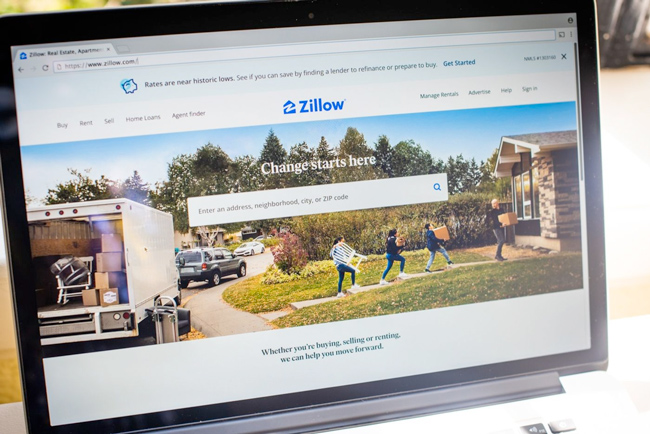Zillow is getting out of the iBuying business and will shut down its Zillow Offers division, resulting in a 25% reduction in its staff.
In its quarterly earnings report on Tuesday, the company said it will see a total write-down of more than $540 million as a result of its exit from the business, which buys homes and resells them.
As a result of shutting down Zillow Offers, the company said it will be cutting some 2,000 jobs.
Last month, the company said it was halting new purchases of homes because supply chain disruptions and the labor shortage were causing it to get backlogged on the homes it was renovating and preparing for sale. However, the company said on Tuesday that the $304 million inventory write down it recorded in the third quarter from its Homes segment, which includes Zillow Offers, was because it bought homes during the last quarter for prices higher than it believes it can sell them.
“We’ve determined the unpredictability in forecasting home prices far exceeds what we anticipated and continuing to scale Zillow Offers would result in too much earnings and balance-sheet volatility,” said Rich Barton, Zillow’s co-founder and CEO.
Since Zillow Offers launched in 2018, real estate markets have experienced major upheaval, including a pandemic, a temporary freezing of the housing market, followed by a supply and demand imbalance that led to an unprecedented rise in home prices.
While the big price swings up were welcome, the swings down would expose Zillow to too much risk, Barton and Allen Parker, the chief financial officer, wrote in the company’s shareholder letter. “Our aim was to become a market maker, not a market risk taker.”
Zillow Offers gave homeowners a fair market cash offer on their home. The idea was to grow that service and offer it to a wider audience. But because of the price forecasting volatility, the company had to reconsider what the business would look like when it had grown larger, a size it needed to become in order to be consistently profitable, Barton and Parker wrote.
“We have determined this large scale would require too much equity capital, create too much volatility in our earnings and balance sheet, and ultimately result in far lower return on equity than we imagined,” they wrote.
The competition in the market amid other iBuyers meant that most proposals Zillow Offers made to homeowners were not taken. Only 10% of offers made were taken. Plus, the services were available only in a handful of cities.
The company had been on a buying binge.
Zillow bought 3,805 homes in the second quarter and sold 2,086. This past quarter, Zillow Offers bought 9,680 homes. That pushed the business of closing on homes and preparing them for sale to a breaking point, however. As a result, Zillow only sold 3,032 homes in the third quarter, which was below expectations and the average gross profit per home sold was a loss of $80,771.
also read :
How Can I Fix an Inaccurate Zillow Home Value Estimate? Zestimate
Zillow closes home-flipping business. What does that say about the reliability of its Zestimate home-valuation tool?
Zillow used Zestimate to help guide the prices it paid for homes through its now-shuttered home-flipping business
Zillow’s ZG, -18.62% experiment in home-flipping has blown up in its face — and the company is blaming the “unpredictability” of home prices.
Now, some are asking about the reliability of the company’s so-called Zestimates, which provides an estimate of a home’s value based on a proprietary formula. Zillow says a Zestimate is published for around 100 million homes nationwide.
In announcing its latest quarterly earnings on Tuesday, Zillow Z, -18.45% confirmed that it will “wind down” its Zillow Offers division that focused on buying homes, refurbishing them and then selling them, hopefully for the profit. But the profit piece was missing.
During the most recent quarter, Zillow’s Homes segment, which includes Zillow Offers, recorded a nearly $422 million loss before taxes. That’s up from a roughly $76 million loss a year earlier. Reports have suggested that the company has already begun offloading some 7,000 homes, with a majority fetching a price below what Zillow paid for the properties.
“We’ve determined the unpredictability in forecasting home prices far exceeds what we anticipated and continuing to scale Zillow Offers would result in too much earnings and balance-sheet volatility,” Zillow Group co-founder and CEO Rich Barton said in the earnings release.
The company said closing its iBuying business segment will “take several quarters” and involve a 25% reduction in the company’s workforce.
In light of the challenges Zillow faced with its home-buying efforts, some people took to social media to call into question the accuracy of the Zestimate tool. “It’s really a toy,” said Mike DelPrete, a real estate analyst who tracks the iBuying sector. “It’s meant to drive people’s interest in property.”
How accurate is the Zestimate?
Complaints about the Zestimate are nothing new. An unsuccessful 2017 class-action lawsuit against Zillow claimed that the company was misleading home buyers by publishing figures that were below what sellers were seeking for their homes. The judge ultimately dismissed the case, noting that the tool’s name “itself indicates that Zestimates are merely an estimate of the market value of a property.”
Zillow says that the Zestimate has a median error rate of 1.9% for homes that are on the market and 6.9% for homes that are off the market.
The accuracy varies significantly across markets. In Cincinnati, for instance, roughly 35% of Zestimates for off-market homes were within 5% of the eventual sales prices, and 82% were within 20% of the price. Comparatively, in Denver, 51% of Zestimates were within 5% of the sales price, and 94% were within 20% of the sales figure.
Challenges in the COVID-era housing market
The red-hot housing market in America since the summer of 2020 likely confounded Zillow’s efforts to appropriately price the homes it was purchasing.
The company’s spokesperson argued that the Zestimate was not at the crux of the pricing issues it faced, instead pointing to difficulties the company had in accurately forecasting “the future price of inventory three to six months out, in a market where there were larger and more rapid changes in home values than ever before.”
As some analysts argued, any real-time valuation will be limited in what it can tell you about the direction of prices in the future. “Valuation is inherently ephemeral,” said Michael Greene, co-founder and CEO of ResiShares, a residential real-estate investment company.
also read :
How Phoenix predicted Zillow’s spectacular crash
Software isn’t ready to take over real estate. Just ask Phoenix, one of the hottest housing markets in the country.
When the real estate tech company Zillow announced Tuesday that it was shutting down its algorithm-fueled home-flipping operation Zillow Offers, few in Phoenix were likely surprised.
Zillow and a cohort of other tech companies including Offerpad, Opendoor, and Redfin had used the growing city’s booming housing market as a proving ground for their disruptive new approach to buying and selling houses. Dubbed iBuying, the tech companies use their deep pockets to quickly buy up homes directly from sellers, relying on algorithms to determine offers, and then flipping the acquired homes for a small profit. Done at volume, these low-margin transactions could add up to millions in revenue.
As iBuying activity has grown over the last three to five years, the housing market in greater Phoenix has proven to be a convenient place to bring algorithm-influenced home flipping to the masses. Ever since the 2008 recession left Phoenix scattered with foreclosed housing, a surging population has turned the devastation into one of the country’s hottest seller’s markets. Companies like Zillow were able to tap into that action. “In order to test the R&D side of this you need a lot of transactions. That’s one of the reasons a market like Phoenix was so attractive to these companies,” says Mark Stapp, a business professor at Arizona State University.
That test has failed, at least for Zillow. Last month, the company confirmed a Bloomberg News report that it was overpaying for homes. Due to a tweak in its algorithm, the company had gotten aggressive and paid too much for too many homes, leaving it with a deep backlog of homes to flip and forcing it to take losses on many of those properties. Zillow soon paused all of its iBuying acquisitions to try to work through its inventory for renovation and resale. Within weeks it was reported that the company was trying to offload 7,000 of these homes to institutional investors for about $2.8 billion. On an earnings call Tuesday, the company announced it had lost almost $330 million in the third quarter, a significant drop from its $40 million quarterly profit just one year ago. The company said it will be winding down Zillow Offers and reducing its roughly 8,000 person workforce by 25%.
It’s a high-profile collapse for the iBuying industry, and one that raises questions about the role these companies can and should play in people’s home-buying decisions. These are questions many in Phoenix have been asking since long before Zillow’s downfall.
Phoenix area real estate agent and YouTuber Greg Corbett had been keeping an eye on the local house flipping activity of the iBuyers.
He had a hunch that the companies’ computer-assisted buying activity was playing the market by slightly different rules. Word kept coming from clients and fellow agents that the iBuyers were making offers for homes that were significantly higher than offers from non-algorithmic sources, sometimes 10% or 20% over the asking price.
Zillow Quits Home-Flipping Business, Laying Off 25% of Its Staff in the Process
The real estate website realized that buying and selling homes is a volatile business. Now it’s laying off a quarter of its workforce.
However, the company’s gamble has not only not paid off, but it has come back to bite it extremely hard in the ass. Vice News recently reported that the company’s focus on growth over actual profits meant that “Offers” has actually been losing a lot of money rather than earning it.
The first signs of real trouble for the division surfaced about two weeks ago, when Zillow reported that it would be halting its home-buying binge due to supply chain and labor shortage issues. Then, a week later, it was reported that the firm had purchased way too many houses and was hemorrhaging money as it was forced to sell them for reduced prices instead of the markups they had hoped for. Now, the wheels would appear to have totally come off and, naturally, mass layoffs have commenced.
“We’ve determined the unpredictability in forecasting home prices far exceeds what we anticipated and continuing to scale Zillow Offers would result in too much earnings and balance-sheet volatility,” said Zillow Group co-founder and CEO Rich Barton. “While we built and learned a tremendous amount operating Zillow Offers, it served only a small portion of our customers. Our core business and brand are strong, and we remain committed to creating an integrated and digital real estate transaction that solves the pain points of buyers and sellers while serving a wider audience.”
Zillow further claims that it will be re-focusing on its “core business”—i.e., providing a digital place for consumers to browse for homes, rather than trying to sell them those homes outright.
Zillow Offers had problems under the surface
There were signs that the program was in trouble — a report on Monday said that Zillow was looking to offload over 7,000 homes it had bought, not to individual buyers but investors. In October, the company announced that it was going to stop buying houses, citing labor shortages as the reason for its excess inventory.












